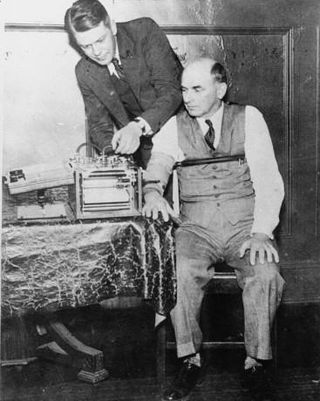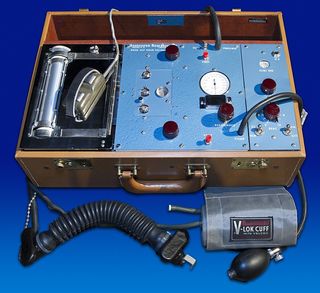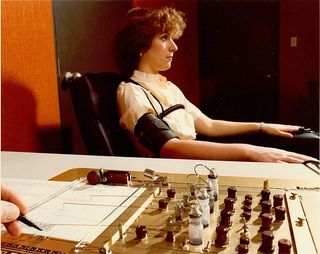Do Lie Detector Tests Really Work? - Psychology Today
Do Lie Detector Tests Really Work? - Psychology Today |
| Do Lie Detector Tests Really Work? - Psychology Today Posted: 14 Jan 2020 12:00 AM PST In February of 1994, the FBI arrested Aldrich Ames, who had been a CIA employee for 31 years. Ames was arrested and charged with espionage. He was a Russian spy. For nine years, he had been passing secrets to the Russians in exchange for over $1.3 million. His spying activities had compromised dozens of CIA and FBI operations. Worse yet, his treacherous crimes had led to the deaths of several CIA spies and the imprisonment of many more. During the time that Aldrich Ames was operating as a Russian spy, the CIA had twice given him a lie detector test. Despite having no special training in how to defeat a lie detector test, Aldrich passed both times.  Source: wikimedia The modern polygraph, better known as the "lie detector test," is a fascinating little instrument with a long and controversial history. The earliest version a polygraph instrument was developed in 1921 when John Larson cobbled together previously developed measures of respiration, heart rate, and blood pressure that had individually shown promise as a measure of lying. Technological developments continued, and the modern polygraph is now an integrated, state-of-the-art, computerized system that continuously monitors blood pressure, heart rate, respiration, and perspiration. The theory behind the polygraph is that when people are lying, they experience a different emotional state than when they are telling the truth. Specifically, it is thought that when people are lying, especially in high stakes scenarios such as police interrogations, they are anxious or afraid of being caught in a lie. When guilty people are asked questions that would reveal their guilt (e.g., Where were you last Tuesday?), and they lie, the fear of being detected causes increased activation of their sympathetic nervous system. This activation leads to an increase in heart rate, blood pressure, respiration, and perspiration. These changes are part of the fight-or-flight system that initiates whenever was are scared. You have probably felt your heart pounding or your palms sweating when faced with danger, be it a vicious dog, an angry boss, or an upcoming exam.  Source: wikimedia The polygraph is designed to detect those subtle changes in a person's physiological responses when they lie. The general idea is that when a person is being honest, their physiological responses remain stable under questioning, whereas a guilty person's heart will race. One of the most common polygraph procedures is called the comparison question test (also called the control question test). The examinee is asked relatively benign questions such as "Where do you live." They are also asked questions that are not relevant to the crime, but which would likely trigger an emotional reaction such as, "Have you ever told a lie?" They are then asked questions about the alleged crime such as, "Did you steal the documents?" The premise of the comparison question test is that a guilty person will have a much stronger physiological reaction to the crime question, whereas an innocent person will not. The polygraph is used in criminal investigations, although it is generally not admissible as evidence in a trial. It is also used as a pre-employment and continuing employment screening tool for many federal employees who work in sensitive positions, such as CIA agents and FBI agents. Private businesses, however, cannot force their employees to submit to a polygraph test. So, does the polygraph actually work? Are the results accurate? It does work much of the time. Typically, when someone is lying, a well-trained polygraph examiner can tell. It is not 100% accurate though. The American Polygraph Association is the world's leading association dedicated to the use of evidence-based scientific methods for credibility assessment. It is an organization whose members are largely polygraph examiners. They estimate the accuracy of the polygraph to be 87%. That is, in 87 out of 100 cases, the polygraph can accurately determine if someone is lying or telling the truth. That sounds pretty impressive, but it is important to keep in mind that the polygraph is failing 13% of the time. The federal government sought an unbiased evaluation of the polygraph, so they tasked the National Academy of Sciences with a full investigation of the polygraph's accuracy. In 2003, this large team of notable scientists came to the conclusion that the polygraph was far less accurate than the polygraph examiners had claimed. Some scientists have claimed that the accuracy may be closer to 75%. This lackluster performance is the reason why polygraphs are not used as evidence in criminal trials. They just cannot be trusted.  Source: wikimedia For more clear evidence that the polygraph is unreliable, just look back to the Alrich Ames case mentioned at the top of this article. Ames lied during his polygraph examinations at the CIA, and he passed each time. In this case, the lie detector test failed. When asked how he passed the polygraph test, Ames said that he followed the advice of his Russian handlers. They told him, "Just relax, don't worry, you have nothing to fear." The Russians knew that the polygraph was flawed. They knew that it was only accurate if the examinee was worried and anxious. They knew that if Ames could just relax, he would pass. |
| Man arrested in connection with teen found dead in Las Vegas sewer drain - FOX5 Las Vegas Posted: 23 Jan 2020 02:13 PM PST  LAS VEGAS (FOX5) -- A man was arrested in connection with the death of a 17-year-old whose body was found in a sewer over the weekend. Jayshawn Bailey, 22, was booked on a murder charge in connection with a body found in a sewer drain Jan. 19 in the 2100 block of Fred Brown Drive near Martin L. King and Lake Mead boulevards. "Police said she was angry and a runaway," said sister Kendra Ward. "She was not [kicked out of the house]. She's old enough to make her own choices but she was not kicked out." According to an arrest report, Bailey called police Jan. 19 around 12:30 p.m. to report a body in a sewer under a manhole near his home. Bailey told police he saw two suspicious people "messing" with the manhole sometime between Dec. 25 and Jan. 1. Two weeks later, Bailey said he went into the manhole and found the body. The report said Bailey went in the manhole and touched the body before going back to his home. Bailey said he felt guilt about finding the body and decided to call police "despite possibly being labeled as a snitch," the report said. The arrest report said Bailey agreed to a polygraph test and DNA sampling. During the homicide investigation, police were made aware of a missing persons report in the same area. Tamyah Trotter, 17, was last seen Dec. 12 at a McDonald's at MLK and Lake Mead boulevards. A description of Trotter's physical appearance and clothing closely matched the black female found in the drain. Police picked up Bailey Jan. 21 and took him to LVMPD headquarters for a polygraph test. The arrest report doesn't detail the results of Bailey's polygraph test, but said when Bailey was confronted with the results, he cried and told police "that he would be honest about what occurred." Bailey said he met Trotter at McDonalds Dec. 12. According to the report, Trotter was upset that she was kicked out of her house. Bailey said he offered to let Trotter stay at his house in the area and made up a bed for her on his floor. Bailey said he was high on Xanax and was drinking wine when Trotter came to his house. The report said Trotter started drinking wine and became aggressive, but it wasn't known if she was on any other drugs. Trotter had a Taser and began to activate it while facing Bailey, according to the report. Bailey placed Trotter in a headlock and he said she became limp after about 10 seconds. Bailey told police he performed CPR on Trotter for about two hours but that she wasn't breathing, the report said. Bailey didn't call police because he was afraid of going to jail, according to the report. The arrest report said Bailey hid Trotter's body inside his bedroom until late Dec. 13 or early Dec. 14. Bailey said he put Trotter inside a trashcan with wheels and dumped her in a sewer drain. "There's no reason for someone to do this to her. She's only 17," Ward said. Bailey said the guilt of knowing the body was in the drain led to him calling 911, according to the report. Bailey said he took Trotter's shoes, backpack, cellphone and Taser to the Pearson Community Center, the report said. The Clark County Coroner's Office confirmed Tamyah Trotters death Thursday afternoon. Her cause and manner of death were still pending. Bailey's first court appearance was set for Wednesday morning. This is a developing story. Check back for updates. |
| You are subscribed to email updates from "polygraph test" - Google News. To stop receiving these emails, you may unsubscribe now. | Email delivery powered by Google |
| Google, 1600 Amphitheatre Parkway, Mountain View, CA 94043, United States | |
Comments
Post a Comment